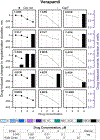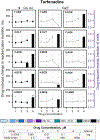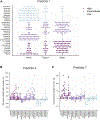International Multisite Study of Human-Induced Pluripotent Stem Cell-Derived Cardiomyocytes for Drug Proarrhythmic Potential Assessment
- PMID: 30257217
- PMCID: PMC6226030
- DOI: 10.1016/j.celrep.2018.08.079
International Multisite Study of Human-Induced Pluripotent Stem Cell-Derived Cardiomyocytes for Drug Proarrhythmic Potential Assessment
Abstract
To assess the utility of human-induced pluripotent stem cell-derived cardiomyocytes (hiPSC-CMs) as an in vitro proarrhythmia model, we evaluated the concentration dependence and sources of variability of electrophysiologic responses to 28 drugs linked to low, intermediate, and high torsades de pointes (TdP) risk categories using two commercial cell lines and standardized protocols in a blinded multisite study using multielectrode array or voltage-sensing optical approaches. Logistical and ordinal linear regression models were constructed using drug responses as predictors and TdP risk categories as outcomes. Three of seven predictors (drug-induced arrhythmia-like events and prolongation of repolarization at either maximum tested or maximal clinical exposures) categorized drugs with reasonable accuracy (area under the curve values of receiver operator curves ∼0.8). hiPSC-CM line, test site, and platform had minimal influence on drug categorization. These results demonstrate the utility of hiPSC-CMs to detect drug-induced proarrhythmic effects as part of the evolving Comprehensive In Vitro Proarrhythmia Assay paradigm.
Keywords: CiPA; comprehensive in vitro proarrhythmia assay; drug-induced ventricular arrhythmia Torsade de Pointes; hiPSC-CM; human-induced pluripotent stem cell-derived cardiomycotes; microelectrode array; voltage-sensitive dyes.
Published by Elsevier Inc.
Conflict of interest statement
DECLARATION OF INTERESTS
The following co-authors are employed by or have declared interests in MEA or VSO platform manufacturer companies: G.S., Clyde Biosciences; D.M., Axion BioSystems; and X.Z., ACEA Biosciences. The following co-authors are employed by or have declared interests in stem cell manufacturer companies: T.K., Cellular Dynamics International; and R.K., Ncardia. G.G. is an employee of and a shareholder in the biopharmaceutical company AbbVie.
Figures







References
-
- Ando H, Yoshinaga T, Yamamoto W, Asakura K, Uda T, Taniguchi T, Ojima A, Shinkyo R, Kikuchi K, Osada T, et al. (2017). A new paradigm for drug-induced torsadogenic risk assessment using human iPS cell-derived cardiomyocytes. J. Pharmacol. Toxicol. Methods 84, 111–127. - PubMed
-
- Asakura K, Hayashi S, Ojima A, Taniguchi T, Miyamoto N, Nakamori C, Nagasawa C, Kitamura T, Osada T, Honda Y, et al. (2015). Improvement of acquisition and analysis methods in multi-electrode array experiments with iPS cell-derived cardiomyocytes. J. Pharmacol. Toxicol. Methods 75, 17–26. - PubMed
-
- Blinova K, Stohlman J, Vicente J, Chan D, Johannesen L, Hortigon-Vinagre MP, Zamora V, Smith G, Crumb WJ, Pang L, et al. (2017). Comprehensive translational assessment of human-induced pluripotent stem cell derived cardiomyocytes for evaluating drug-induced arrhythmias. Toxicol. Sci 155, 234–247. - PMC - PubMed
-
- Clements M, and Thomas N (2014). High-throughput multi-parameter profiling of electrophysiological drug effects in human embryonic stem cell derived cardiomyocytes using multi-electrode arrays. Toxicol. Sci 140, 445–461. - PubMed
-
- Colatsky T, Fermini B, Gintant G, Pierson JB, Sager P, Sekino Y, Strauss DG, and Stockbridge N (2016). The Comprehensive in Vitro Proarrhythmia Assay (CiPA) initiative - update on progress. J. Pharmacol. Toxicol. Methods 81, 15–20. - PubMed
Publication types
MeSH terms
Grants and funding
LinkOut - more resources
Full Text Sources
Other Literature Sources

